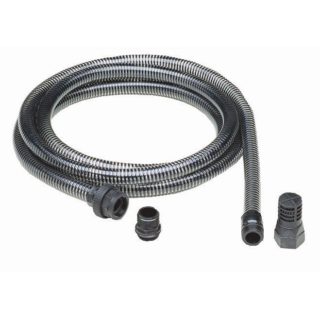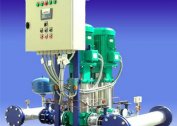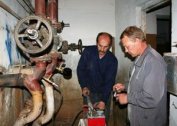One of the important components for an autonomous water supply system is a water intake hose for a pumping station. The performance of the system depends on its strength, elasticity, strength. If the sleeve fails (breaks, deforms), the pressure in the pipeline drops, the fluid does not flow into the valves, the pumping equipment either runs idle or shuts down.
Purpose of a hose for a pump station
A reliable water supply sleeve is used for such purposes:
- fluid intake from the source and its transportation to the storage chamber of the unit;
- water transfer further through the system;
- watering, irrigation of garden crops.
It is desirable that the intake hose has a sufficient wall thickness. Otherwise, the material will tear quickly, especially when it is used in the garden with constant movement or when working with high pressure.
Types of hoses
All water supply hoses are classified by length, section and materials. The last parameter is important. There are such varieties of hoses on the market:
- Rubber. The most flexible of all models. The main advantages are elasticity, favorable price. However, the rubber hose cannot withstand high pressure, which is inevitable, especially when water is supplied from the well. In addition, at low subzero temperatures, rubber dubs. As a result, such a flexible hose for the pumping station bursts faster.
- Silicone Also characterized by increased elasticity and softness. However, these same qualities work against mounting the silicone sleeve at the inlet to the pumping station. Especially if the rise of water goes vertically at high altitude (well). Here the hose may simply not withstand the weight of water in it and additional equipment (check valve, filters). Silicone hoses are best used only in summer for watering.
- PVC sleeves. Polyvinyl chloride is more rigid than rubber and silicone. It withstands mechanical stress, temperature and pressure drops.
- Silicone
- Rubber
- PVC
In addition to materials, design features of the pump station hose are distinguished. For each type of water supplying sleeves, two versions are possible:
- The usual. It does not suggest anything in the thickness of the walls, except for the main material (silicone or rubber). Such suction hoses are not reinforced in any way. The service life of the products with careful handling is 5-7 years. The maximum working pressure is 3 atm.
- Reinforced (reinforced). Production technology involves the introduction of steel thread into the thickness of the base material. This technique allows you to extend the life of the product up to 20 years, but reduces its elasticity. Reinforced hoses withstand temperature extremes and can operate at high pressure from 7 to 24 atm. Technical characteristics of reinforced hoses: internal section from 8 to 30 cm; radial bend 11-41 cm; wall thickness from 2.6 to 4.5 mm.
When buying a high-pressure hose for a pumping station, you should take care of reliable durable fittings and fittings for it. Otherwise, the sleeve may be ripped off during operation.
There is a variety of reinforced sleeves - corrugated. They are based on a strong metal spiral. At the same time, lightweight corrugation can be used specifically for pumping equipment. The heavy and medium types of spirals are operated in drainage systems because they have greater rigidity.
Criterias of choice
When buying hoses for pumping equipment, it is advisable for the master to rely on such criteria:
- Length of the product. It should be enough from the point of water intake to the unit. If the length of the sleeve is excessively large and at the same time there is reinforcing fiber in the material, it will be difficult to twist the hose, and cut into two pieces is a pity. Short-sleeved is even harder.
- The material of manufacture. For systems operating under high pressure, it is better to take reinforced PVC hoses. For watering, you can use rubber, silicone products.
- Rigidity. It is extremely important if the sleeve is designed to operate in conditions of changing temperatures and pressure indicators. The reinforced hose will not lose its shape from this, will not collapse or deform. The best solution is corrugated or reinforced hoses.
- Frost resistance of the material. It is especially important if the sleeve is bought for operation at low temperatures (northern regions of Russia).
- Section. The diameter of the hose in inches must exactly match the size of the inlet.
When choosing products, it is better to take ready-made hoses with a check valve. Additionally, you need to buy fittings, coarse filters, gaskets. If there is a need to arrange a turn of the line at an angle of 35-55 degrees, you can buy a short metal hose. This will eliminate water hammer.
Features of installation and operation
To independently connect the sleeve to the pumping station, you should prepare strong clamps and a coil of knitting wire. First, one end of the hose should be immersed in soapy or hot water. Such manipulation will make it easier to put the hose on the inlet nozzle.
At the end of the sleeve, put on two clamps and gently push them along the thread a little further from the edge by 5-7 cm.
The prepared hose is pulled onto the nozzle, carefully loosening it from side to side or scrolling clockwise. The worn sleeve is fixed with clamps.
For proper operation of the hose, it is better to adhere to the following recommendations:
- It is advisable to lay the sleeve with a slope of 5 degrees from the point of water intake to the unit. Thanks to this approach, freezing in the pipeline is excluded in winter.
- It is advisable to avoid kinks in the water supply line.
- If the hose will not be used in the winter, it is either removed together with the station or a water lock is made through a slight sagging of the sleeve.
A correctly selected and installed water intake hose serves without failures, deformations, or tears.







